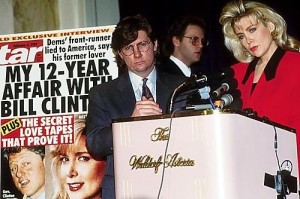 If Governor Clinton had been up to his shenanigans in the “Fifth Estate” age, do you think he could still win the U.S. presidency? Or would the citizen media’s ability to document indiscretions and spread them virally have squelched his political ambitions?
If Governor Clinton had been up to his shenanigans in the “Fifth Estate” age, do you think he could still win the U.S. presidency? Or would the citizen media’s ability to document indiscretions and spread them virally have squelched his political ambitions?
It’s hard to say for sure. But without a doubt his successful message control strategies wouldn’t work today. As Geoff Livingston, Zoetica cofounder, emphasizes in his new book, Welcome to the Fifth Estate:
“Telling people what they want to hear or sticking to your three messages, truthful or not [no longer works]. Faced with social media, PR practitioners need to unlearn, retrain and change. … Message control in social media environments doesn’t work; two-way conversational capabilities have permanently closed the door on that strategy,” he writes.
 Ironically, U.S. Rep. Anthony Weiner (D-NY), has reportedly sought advice from President Clinton on his Weinergate scandal and (coincidentally or not) reportedly attempted to copy President Clinton’s message control playbook by encouraging women to lie about their relationship with him and offering them the help of his public relations team.
Ironically, U.S. Rep. Anthony Weiner (D-NY), has reportedly sought advice from President Clinton on his Weinergate scandal and (coincidentally or not) reportedly attempted to copy President Clinton’s message control playbook by encouraging women to lie about their relationship with him and offering them the help of his public relations team.
Apparently Weiner was too busy with his Internet sexcapades to notice how Web 2.0 sunk the career of his New York colleague, Republican Rep. Chris Lee, who got caught sending a shirtless photo of himself to a woman he met through Craigslist. Or perhaps he thought his close personal connections to a message control master gave him a unique advantage?
I think we can safely say that Weiner and those advising him should have realized things have completely changed and President Clinton’s message control wizardry can no longer be replicated. They should have realized the new rules of communications required Weiner to tell the truth immediately. As Livingston writes in Welcome to the Fifth Estate, today you need ethics and transparency to win at the public relations game:
“Trust needs to be fostered through strong ethical action in social networks of any kind. Without actions to back up the talk, there’s little hope of success,” he writes, adding later: “If the public’s trust is broken by an organization misrepresenting itself, regaining it will be difficult. The Fifth Estate expects an organization to represent itself ethically online and demonstrate transparency in organizational efforts, especially in crisis situations.”
That means when Weiner got caught, he should have fessed up immediately, admitted he suffers from a terrible addiction, and went into treatment… especially with a child on the way. If you disagree and think messages still can be controlled, read Livingston’s new book. It provides an excellent foundation of the strategic principles of social network marketing and will help you unlearn what you were taught in business or communications school and, if necessary, step out of the darkness.
Do you disagree that the “Fifth Estate” is changing all the rules of communications? If you think my analysis is wrong, challenge me.




